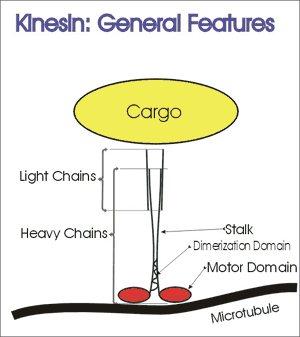|
||||||||||||
|
|
||||||||||||
KinesinIntroduction
In the cell, kinesin acts as a tetramer of two heavy chains and two light chains, the heavy chains containing the motor domain (that binds the Microtubules and ATP) and a long stalk that attach to the light chain. The light chains in turn attach to the cargo. The cargo can be anything from vesicles of neurotransmitters to chromosomes or organelles. The crystal structures of kinesin only include the motor domain, and a small portion of the stalk, known as the neck. One crystal structure includes the dimerization domain. Very little is known about the structure of the stalk. It is believed to be a long stretch of coiled-coil a-helix and random coil. Relevant Units |
 |
 |
Copyright 2006, John Wiley & Sons Publishers, Inc. |
 |
 |
 Kinesins are microtubule-associated motor proteins that convert the chemical energy of ATP bonds to directional kinetic energy. It does this by moving along microtubules. Kinesins are involved in many intracellular processes including chromosomal segregation during mitosis and transport of vesicles and organelles within living cells. The kinesins are the simplest relative of the motor proteins that include the classes of the dyneins and myosins. Kinesin also has homology to the g-subunit of the cellular messenger G-proteins.
Kinesins are microtubule-associated motor proteins that convert the chemical energy of ATP bonds to directional kinetic energy. It does this by moving along microtubules. Kinesins are involved in many intracellular processes including chromosomal segregation during mitosis and transport of vesicles and organelles within living cells. The kinesins are the simplest relative of the motor proteins that include the classes of the dyneins and myosins. Kinesin also has homology to the g-subunit of the cellular messenger G-proteins.